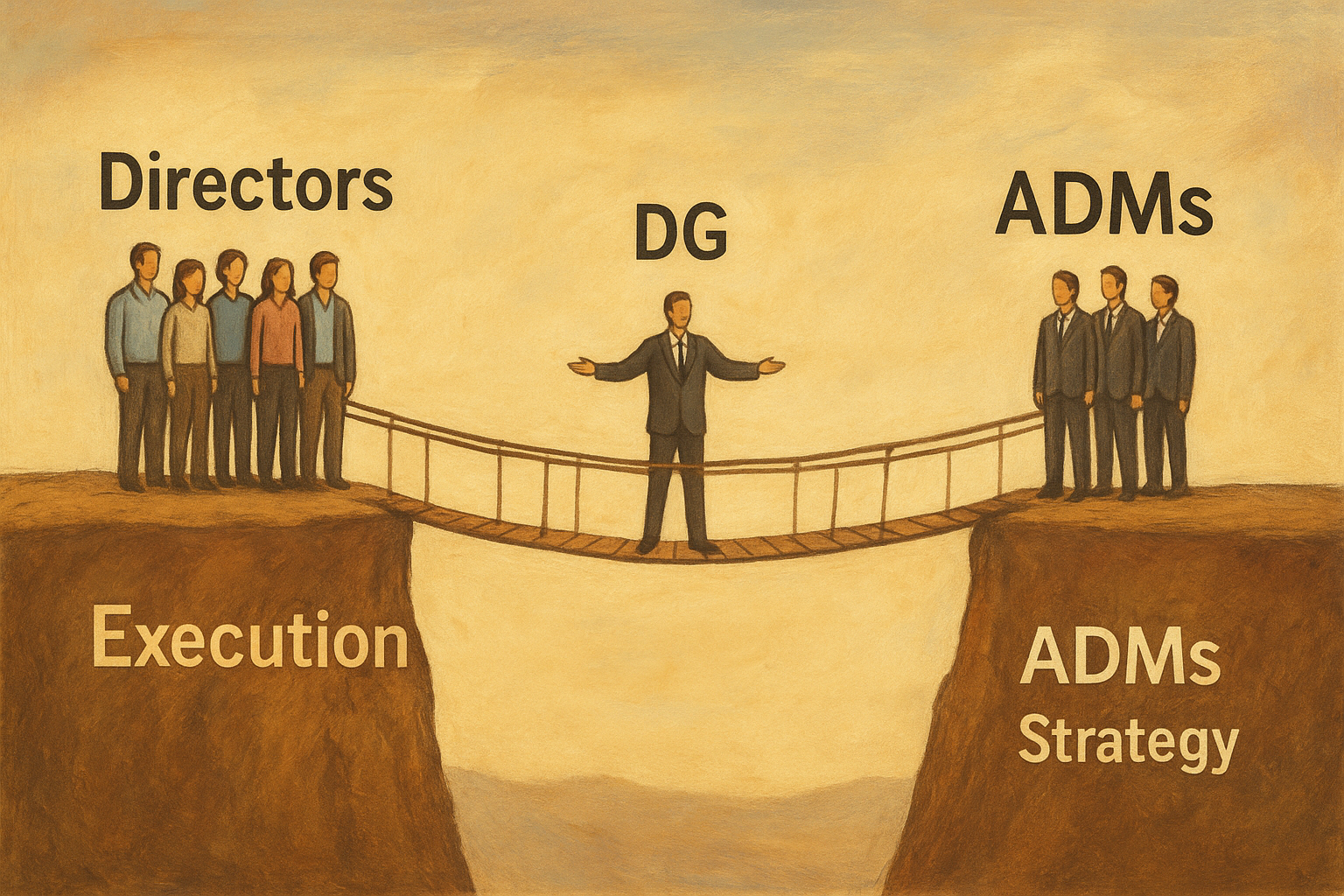DGs at the Operational Frontline
Directors General (DGs) occupy a critical role in government transformation: translating strategic intent into operational execution. In digital initiatives, DGs ensure that directorates adopt new tools, processes, and behaviors, balancing innovation with operational reliability and regulatory compliance. While Ministers and Deputy Ministers provide political direction and governance frameworks, DGs deliver tangible outcomes, making transformation real for staff and citizens.

The success of digital reform depends on DGs who can navigate complex interdependencies, manage resources, empower teams, and communicate results upward. They serve as operational sponsors, bridging the gap between strategic ambition and day-to-day execution.
DG Roles in Digital Transformation
- Operationalizing Strategy
- Convert departmental digital goals into actionable work plans, timelines, and deliverables.
- Ensure projects align with both DMs’ expectations and Ministers’ mandate letters.
- Staff Engagement and Capacity Building
- Coach teams in adopting new tools, processes, and ways of working.
- Foster confidence, resilience, and a culture of continuous learning within directorates.
- Resource Coordination
- Allocate personnel, budget, and technical resources effectively.
- Identify gaps early and escalate when necessary.
- Monitoring and Reporting
- Track key performance indicators (KPIs) and metrics for adoption, efficiency, and service delivery.
- Provide timely updates to ADMs, flag risks, and recommend corrective action.
- Decision-Making and Problem-Solving
- DGs must make operational choices, sometimes going against the grain of established culture, to ensure success.
- They must balance political sensitivities with practical realities, ensuring solutions are both innovative and feasible.
Challenges for DGs
- Resistance to Change
Staff accustomed to legacy systems may resist adoption. DGs must employ coaching, incentives, and transparent communication to overcome skepticism. - Resource Limitations
Digital initiatives compete with ongoing operations for funding, personnel, and technical support. DGs must prioritize and allocate resources judiciously. - Complex Interdependencies
Projects often span multiple branches and departments, requiring coordination, negotiation, and influence without direct authority over all stakeholders. - Accountability Under Scrutiny
DGs’ decisions are closely monitored by ADMs and DMs. Mistakes can have reputational, operational, and political consequences.
Best Practices for DGs
- Visible Operational Sponsorship
- Lead by example; demonstrate commitment to digital adoption in meetings, communications, and decision-making.
- Empower and Coach Directors
- Delegate responsibility, provide guidance, and ensure staff understand expectations, timelines, and objectives.
- Integrate Transformation into Daily Operations
- Embed new processes into routine workflows to ensure adoption is sustainable rather than temporary.
- Balance Innovation with Compliance
- Encourage experimentation while maintaining security, privacy, and regulatory compliance standards.
- Align KPIs with Transformation Goals
- Track adoption metrics, efficiency gains, and service quality improvements to measure progress and justify continued support.
- Communicate Upward and Outward
- Provide ADMs with clear updates, escalate issues when necessary, and celebrate successes to reinforce momentum.
Case Example: Digital Citizen Service Rollout
A federal department implemented a new online citizen service portal:
- Ministerial Role: Articulated a “digital-first” mandate and secured funding.
- DM Role: Provided governance and operational oversight, coordinated cross-branch initiatives.
- ADM Role: Integrated IT, finance, and operational branches; developed KPIs and timelines; empowered DGs.
- DG Role: Oversaw operational rollout, coached directorates, resolved technical and staffing challenges, and reported metrics to ADMs.
Outcome: Service uptake increased by 50%, average processing times decreased, and staff reported greater confidence using new digital systems. DG leadership was critical to translating strategy into operational reality.
Risks of Weak DG Sponsorship
Without strong DG involvement:
- Fragmented Implementation: Initiatives may stall or diverge from intended outcomes.
- Staff Disengagement: Resistance and confusion reduce adoption rates.
- Failure to Meet KPIs: Departments cannot demonstrate value or impact, jeopardizing political and operational support.
- Erosion of Trust: Inconsistent execution undermines confidence from ADMs, DMs, and Ministers.
Studies consistently highlight DG-level leadership as pivotal in operationalizing reforms, ensuring that strategic directives become measurable, sustainable results (Balogun, 2003; Fernandez & Rainey, 2006).
Supporting DGs in Their Role
To enhance DG impact:
- Leadership Coaching: Focus on operational decision-making, staff engagement, and risk management.
- Operational Tools: Dashboards, templates, and frameworks support tracking, reporting, and coordination.
- Cultural Support: Equip DGs to champion change, navigate resistance, and foster innovation.
- Peer Networks: Enable sharing of lessons learned, emerging practices, and operational solutions across departments.
Conclusion
DGs are the operational backbone of digital transformation. Their ability to convert strategy into tangible outcomes, empower teams, and manage complex interdependencies determines whether transformation initiatives succeed or fail.
Strong DG sponsorship ensures:
- Strategic objectives are realized at the operational level
- Staff are engaged, trained, and confident
- Innovation is adopted without compromising compliance or continuity
- Outcomes are measurable, sustainable, and aligned with Ministerial and DM expectations
By integrating strategy, managing resources, coaching staff, and reporting effectively, DGs make transformation actionable. Their leadership converts vision into reality, delivering measurable value for citizens and government alike.
What’s Next?
Institute X partners with DGs to provide leadership coaching, operational frameworks, and tools to embed digital transformation successfully.
References:
- Balogun, J. (2003). From blaming the middle to harnessing its potential: Creating change intermediaries. British Journal of Management, 14(1), 69–83.
- Fernandez, S., & Rainey, H. G. (2006). Managing successful organizational change in the public sector. Public Administration Review, 66(2), 168–176.
- Kotter, J. P. (2012). Leading Change. Harvard Business Review Press.


Leave a Reply
You must be logged in to post a comment.